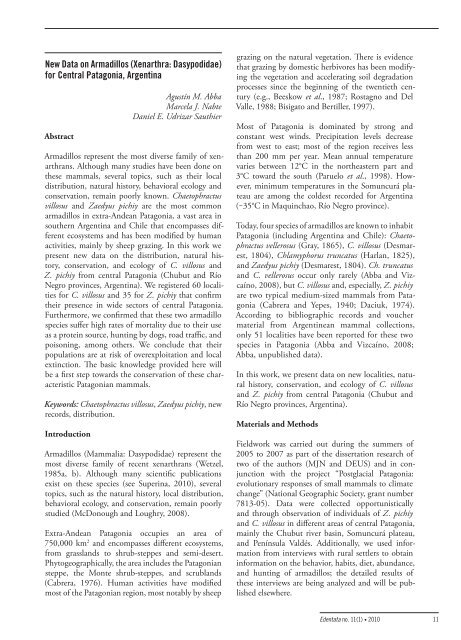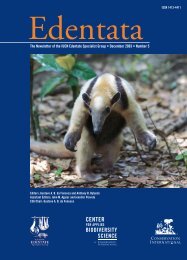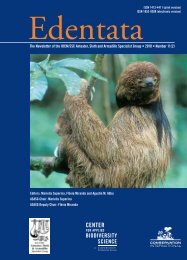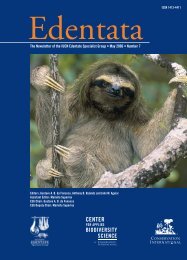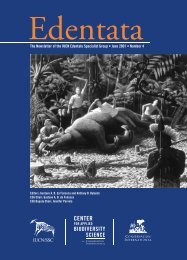Edentata 11(1) - Anteater, Sloth & Armadillo Specialist Group
Edentata 11(1) - Anteater, Sloth & Armadillo Specialist Group
Edentata 11(1) - Anteater, Sloth & Armadillo Specialist Group
You also want an ePaper? Increase the reach of your titles
YUMPU automatically turns print PDFs into web optimized ePapers that Google loves.
New Data on <strong>Armadillo</strong>s (Xenarthra: Dasypodidae)<br />
for Central Patagonia, Argentina<br />
Abstract<br />
Agustín M. Abba<br />
Marcela J. Nabte<br />
Daniel E. Udrizar Sauthier<br />
<strong>Armadillo</strong>s represent the most diverse family of xenarthrans.<br />
Although many studies have been done on<br />
these mammals, several topics, such as their local<br />
distribution, natural history, behavioral ecology and<br />
conservation, remain poorly known. Chaetophractus<br />
villosus and Zaedyus pichiy are the most common<br />
armadillos in extra-Andean Patagonia, a vast area in<br />
southern Argentina and Chile that encompasses different<br />
ecosystems and has been modified by human<br />
activities, mainly by sheep grazing. In this work we<br />
present new data on the distribution, natural history,<br />
conservation, and ecology of C. villosus and<br />
Z. pichiy from central Patagonia (Chubut and Río<br />
Negro provinces, Argentina). We registered 60 localities<br />
for C. villosus and 35 for Z. pichiy that confirm<br />
their presence in wide sectors of central Patagonia.<br />
Furthermore, we confirmed that these two armadillo<br />
species suffer high rates of mortality due to their use<br />
as a protein source, hunting by dogs, road traffic, and<br />
poisoning, among others. We conclude that their<br />
populations are at risk of overexploitation and local<br />
extinction. The basic knowledge provided here will<br />
be a first step towards the conservation of these characteristic<br />
Patagonian mammals.<br />
Keywords: Chaetophractus villosus, Zaedyus pichiy, new<br />
records, distribution.<br />
Introduction<br />
<strong>Armadillo</strong>s (Mammalia: Dasypodidae) represent the<br />
most diverse family of recent xenarthrans (Wetzel,<br />
1985a, b). Although many scientific publications<br />
exist on these species (see Superina, 2010), several<br />
topics, such as the natural history, local distribution,<br />
behavioral ecology, and conservation, remain poorly<br />
studied (McDonough and Loughry, 2008).<br />
Extra-Andean Patagonia occupies an area of<br />
750,000 km 2 and encompasses different ecosystems,<br />
from grasslands to shrub-steppes and semi-desert.<br />
Phytogeographically, the area includes the Patagonian<br />
steppe, the Monte shrub-steppes, and scrublands<br />
(Cabrera, 1976). Human activities have modified<br />
most of the Patagonian region, most notably by sheep<br />
grazing on the natural vegetation. There is evidence<br />
that grazing by domestic herbivores has been modifying<br />
the vegetation and accelerating soil degradation<br />
processes since the beginning of the twentieth century<br />
(e.g., Beeskow et al., 1987; Rostagno and Del<br />
Valle, 1988; Bisigato and Bertiller, 1997).<br />
Most of Patagonia is dominated by strong and<br />
constant west winds. Precipitation levels decrease<br />
from west to east; most of the region receives less<br />
than 200 mm per year. Mean annual temperature<br />
varies between 12°C in the northeastern part and<br />
3°C toward the south (Paruelo et al., 1998). However,<br />
minimum temperatures in the Somuncurá plateau<br />
are among the coldest recorded for Argentina<br />
(−35°C in Maquinchao, Río Negro province).<br />
Today, four species of armadillos are known to inhabit<br />
Patagonia (including Argentina and Chile): Chaetophractus<br />
vellerosus (Gray, 1865), C. villosus (Desmarest,<br />
1804), Chlamyphorus truncatus (Harlan, 1825),<br />
and Zaedyus pichiy (Desmarest, 1804). Ch. truncatus<br />
and C. vellerosus occur only rarely (Abba and Vizcaíno,<br />
2008), but C. villosus and, especially, Z. pichiy<br />
are two typical medium-sized mammals from Patagonia<br />
(Cabrera and Yepes, 1940; Daciuk, 1974).<br />
According to bibliographic records and voucher<br />
material from Argentinean mammal collections,<br />
only 51 localities have been reported for these two<br />
species in Patagonia (Abba and Vizcaíno, 2008;<br />
Abba, unpublished data).<br />
In this work, we present data on new localities, natural<br />
history, conservation, and ecology of C. villosus<br />
and Z. pichiy from central Patagonia (Chubut and<br />
Río Negro provinces, Argentina).<br />
Materials and Methods<br />
Fieldwork was carried out during the summers of<br />
2005 to 2007 as part of the dissertation research of<br />
two of the authors (MJN and DEUS) and in conjunction<br />
with the project “Postglacial Patagonia:<br />
evolutionary responses of small mammals to climate<br />
change” (National Geographic Society, grant number<br />
7813-05). Data were collected opportunistically<br />
and through observation of individuals of Z. pichiy<br />
and C. villosus in different areas of central Patagonia,<br />
mainly the Chubut river basin, Somuncurá plateau,<br />
and Península Valdés. Additionally, we used information<br />
from interviews with rural settlers to obtain<br />
information on the behavior, habits, diet, abundance,<br />
and hunting of armadillos; the detailed results of<br />
these interviews are being analyzed and will be published<br />
elsewhere.<br />
<strong>Edentata</strong> no. <strong>11</strong>(1) • 2010 <strong>11</strong>


